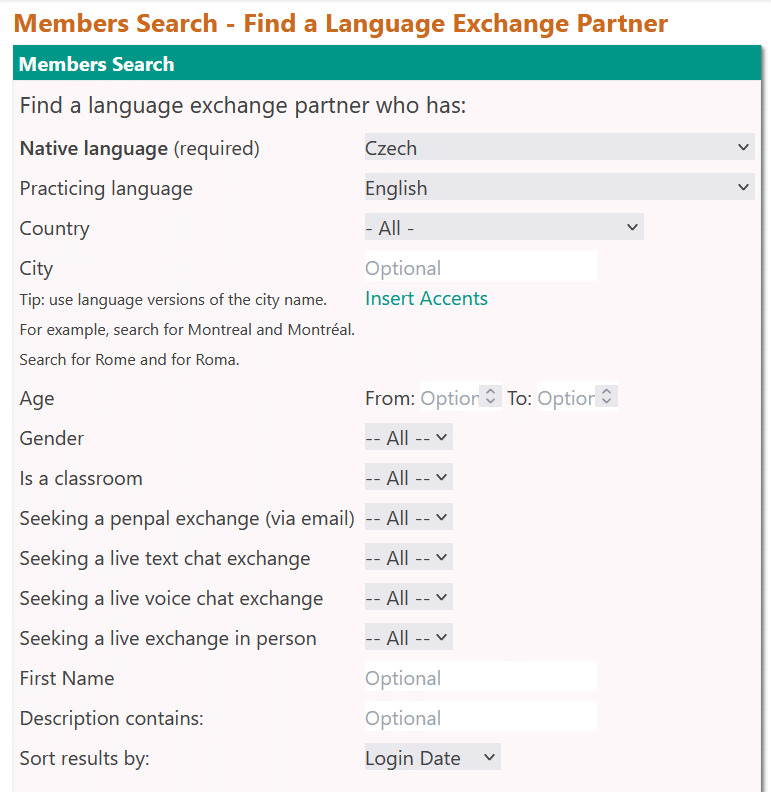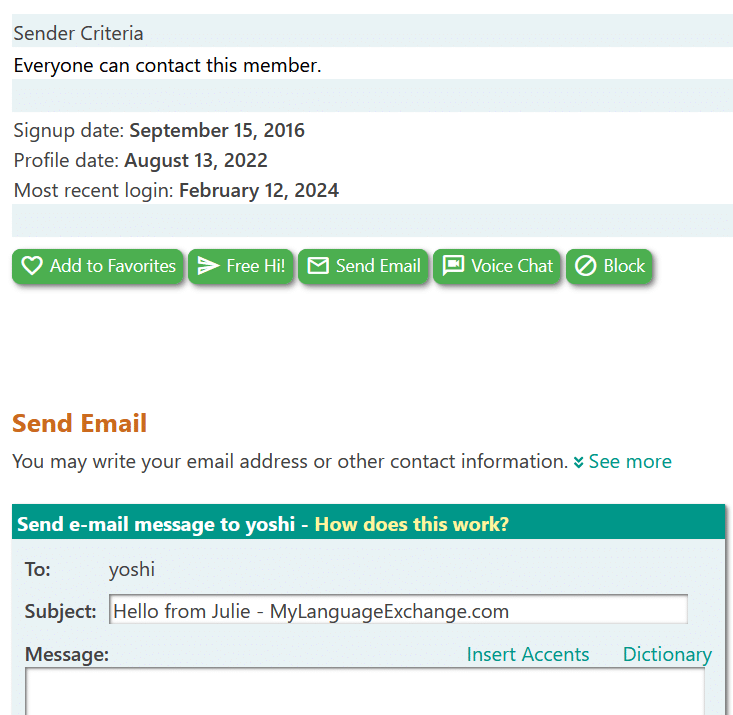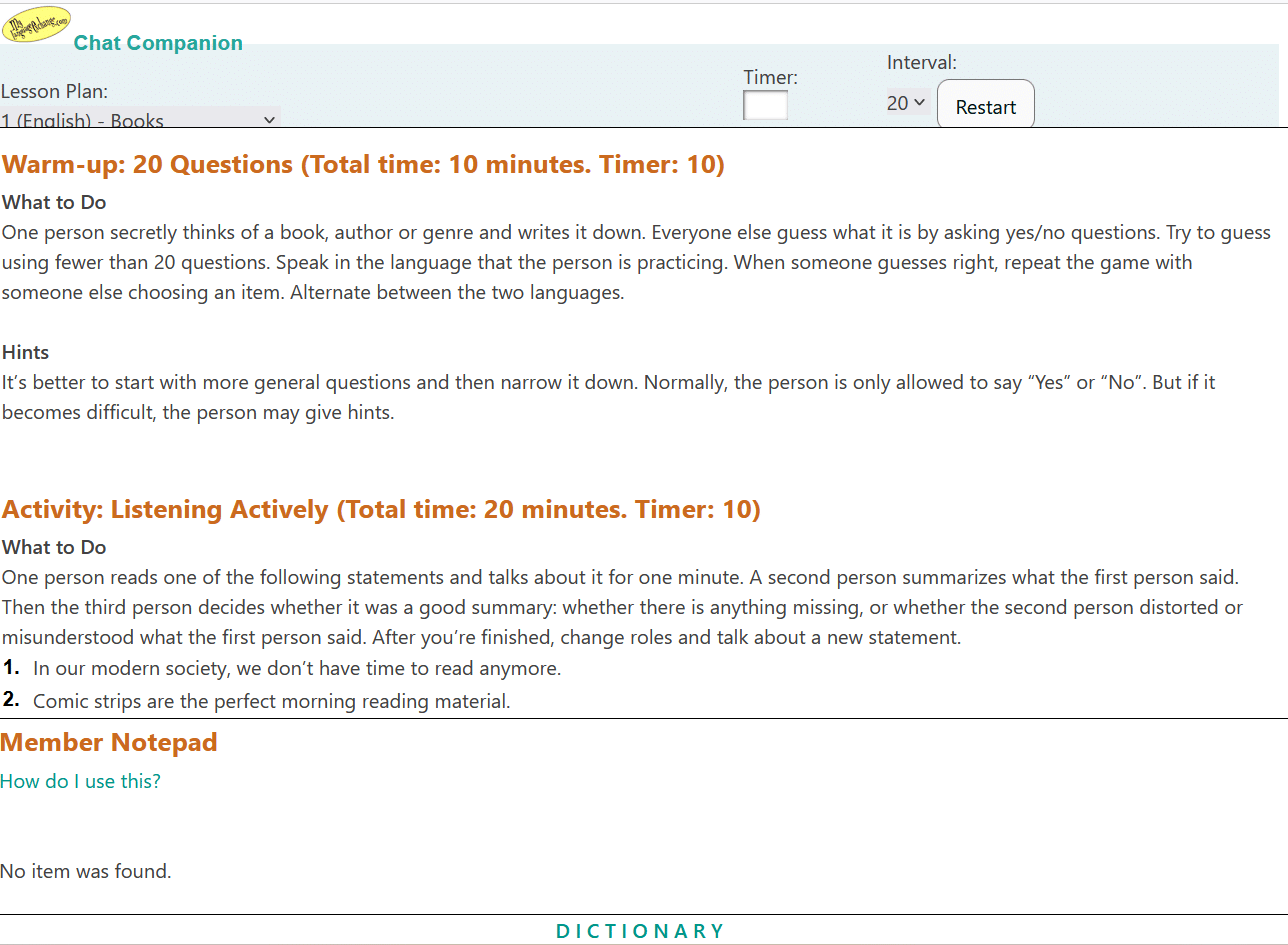
MyLanguageExchange Review: Old-school Penpals for Language Learning
As great as language learning apps are today, nothing beats having an actual human being to practice with.
MyLanguageExchange is an old-school resource for finding someone to practice your target language with.
The program guides you through finding a language partner and having a productive exchange.
Though it’s free to join, the database doesn’t become useful unless you subscribe to the Gold membership. Once you’re subbed up, though, you’ll have thousands of potential language partners to chat with!
The website might look like it hasn’t changed since the 2000s, it’s an amazing resource for finding a long-term, serious language partner—and maybe even a friend!—who speaks the language that you’re learning… and vice versa.
What else should you expect of MyLanguageExchange? Read the review below to discover everything the program has to offer, and see a firsthand account of an actual language learner.
Overview

Name: MyLanguageExchange
Description: An old-school resource for finding someone to practice your target language with.
Languages offered: Nearly every language you can imagine, from Afrikaans to Zulu, and everything in between.
Offer price: Some features available for free; Gold Membership at $5.99 per month, $11.99 for three months or $23.99 for a year
Summary
MyLanguageExchange is a huge community of language learners. It has an outdated style and not too many features but its simplicity has a charming appeal in a world of shiny apps. A great search engine makes it easy to find a partner among the three million (plus) users. Out of all the language exchange platforms out there, this one seems to be full of people genuinely looking to connect and learn a language together.
- User friendliness - 6/106/10
- Delivers on promises - 7/107/10
- Authenticity - 10/1010/10
- Value for price - 5/105/10
Pros
- Powerful search helps you find the right language exchange partner for you
- Has helpful guides, lessons and activities for conducting a successful language exchange
- Built-in text and voice chat facilitate conversation
- Thousands of active users makes it easy to find a partner
Cons
- Old-looking website with some defunct features (like a dead forum)
- Can’t initiate conversation with someone unless you or they are Gold Members
- Not many features besides the basics, and most users prefer to chat off the website
Contents
- What Is MyLanguageExchange?
- Finding a Language Exchange Partner on MyLanguageExchange
- Having a Successful Language Exchange on MyLanguageExchange
- Using the Rest of the Website
- Safety and Privacy
- My Journey to Learn Japanese with MyLanguageExchange
- Final Thoughts on MyLanguageExchange
- And One More Thing...
Download: This blog post is available as a convenient and portable PDF that you can take anywhere. Click here to get a copy. (Download)
What Is MyLanguageExchange?
MyLanguageExchange claims to be the world’s largest language exchange community, with over three million members. Founded in 2000, it’s also one of the oldest—something that’s quite apparent from the 2000s era website design and the proud claim of “as seen in Yahoo! Internet Life magazine, January 2001.”
The program is a database goldmine of interested language learners in nearly every language you can imagine. Exchanges are supported by a proven language exchange method (more on this in a bit), as well as a powerful search engine and a number of helpful features to ensure that your language exchange session goes well.
The website’s goal is to connect language learners and teach them how to have an exchange that benefits everyone. They boast of having activities and a tutorial designed by expert teachers.
With MyLanguageExchange, you should be able to find the perfect language partner, as well as know exactly how to conduct a useful session, every time you meet.
Finding a Language Exchange Partner on MyLanguageExchange
Powerful member search
Finding the perfect language partner is easy with MyLanguageExchange’s robust search engine. You can search for a partner by native language and language they’re learning, as well as age, gender, city, country, whether they’re interested in text, email, voice or in-person language exchange and more. You can even sort the results by login date, to make it easier to find someone who’s been recently active on the website.
I did a few searches for a Japanese speaker looking to learn English and got almost 12,000 pages of results! Narrowing it down to people who live in NYC still turned up three pages of options, if I were interested in in-person exchange. I also had no problems finding Japanese speakers who live in the area that I’ll be visiting on a trip to Japan this year.
Requires membership to contact members
But all these amazing opportunities remain just out of reach unless you have a Gold membership. The only contact you can have with other free members is an exchange of “Hi!”s. You have a daily limit of 40 free “Hi!”s to show that you’re interested in starting a conversation with someone.
Only Gold members can start conversations with other users. But if a Gold member contacts you, you’re able to respond. There’s no way to tell if someone is a Gold member from their profile, so as a free user, you’re limited to sending out some hellos and hoping that someone will respond—or waiting for a Gold member to reach out to you.
The key to the latter seems to be just to log in! In the time that I was logged in to gather screenshots and information for this review, I had three people reach out to me.
Having a Successful Language Exchange on MyLanguageExchange
Guide to proven method of language exchange
MyLanguageExchange doesn’t just throw you into the deep end of language exchange and hope for the best. The website has a useful guide to doing a successful language exchange using the Cormier method, developed by the founders of the website, Helene Cormier and Dan Yuen. The guide takes you through how to make the most of your session to benefit everyone who’s taking part, including info on how to prepare, what to do during the exchange and how to review following the exchange.
While all my experiences have been limited to one-on-one, MyLanguageExchange actually recommends that you have groups of between two to four people in each session.
Built-in text and voice chat
There’s a text and voice chat (the latter is for Gold members only) available directly on the website. While you can easily move off the website to have your language exchange sessions—and from my experience, most users prefer to—there are built-in tools that you might find useful.
The text chat has a “Chat Companion,” where you’ll find lesson plans designed specifically for language exchange, a timer to let you know when it’s time to switch languages, a multi-language dictionary and a notepad. There’s also a way to add in accents, which is useful for Latin-based alphabets, but not for any languages that use a different form of writing.
Unless I was doing something wrong, there aren’t that many lesson plans. It seems that these lesson plans, activities and questions are meant to get you started and give you an idea of what to do, so you can progress according to what you and your partner(s) needs.
Language-learning enhanced voice chat
The voice chat also has a translation option for over 130 languages. Rather than a phone call-style exchange, the voice chat works more like sending voice text messages. This takes some of the pressure off from having to talk “in real time,” giving you the chance to formulate your responses with more thought.
All that being said, if you choose to move off the website for your exchange, you’re on your own. Whether you use the built-in tools is up to you and your partner, but it’s nice to know that the option exists.
Using the Rest of the Website
Besides browsing user profiles, sending out hopeful “Hi!” pings and using the text and voice chat, MyLanguageExchange has a few other features. They’re far from the main attraction of the site, but they’re still worth a mention since they’re available if you want some variety.
There are a few word games like hangman and word match, which are made by other users (you can make your own, too!).
You can also find a number of lessons created by users. These are generally brief and to-the-point. Users can rate the lessons but the quality and number of available lessons vary widely for each language.
There’s the “Club Library,” where you can find public notes taken by other users.
One more noteworthy feature is a listing of teachers and tutors if you want a more formal learning experience. Many of these are the teachers who created the lessons, so if you find a lesson that you like, it’s worth checking who created it! You might be able to book a lesson with them.
There’s also a bulletin board, which looks like it works more like a classic internet forum. While it looks like it was widely used in the heyday of the website, I couldn’t find a single language that had been used within the past week.
Safety and Privacy
For the most part, it seems that MyLanguageExchange is truly full of people who really want to study languages and meet native speakers of their target language(s).
Still, any time an online exchange occurs between people, there’s always the risk of poor behavior or harassment. I personally never had a bad experience with this program, but in my research I found at least one instance of someone just starting a chat to ask for pics.
The website is strict about being only for language exchange. Not only is abuse and harassment not allowed, but neither is advertising or recruiting of any kind. The platform strives to be a safe space for all its users.
While there doesn’t seem to be a way to easily report a user, you can easily block them. If you want to report a disruptive user, you’re encouraged to use the built-in contact form. I personally like this compromise, because people can sometimes get trigger happy on “report” buttons, reporting users who disagree with them, for instance, instead of having a legitimate issue.
My Journey to Learn Japanese with MyLanguageExchange
We’ve explored the features of MyLanguageExchange, but how does it feel to actually use it? I’ve used the program several times in the past years, always with great results.
When I first joined, I sent out many “Hi!” messages, as the website suggests. A bit surprisingly, this actually worked! Of course, there were plenty of misses that didn’t go beyond the quick hi, but a large handful of people actually responded or initiated conversation themselves.
Some of the conversations didn’t get off the ground, petering out after a few messages back and forth. But you can’t expect to get along with every person you meet!
The conversations that did flourish were memorable and informative.
I got to chat with a wonderful young lady living in Tokyo, who had just had her first baby. From her, I learned about Japanese culture—like birthing and naming rituals—and we continued to chat for about a year through LINE before eventually falling out of touch.
I also made a connection with an older man from Osaka over email who delighted in telling me about his travels around the country on his beloved bike, checking out onsens and foot baths. He taught me that, unlike what my textbooks taught me, sometimes it’s okay to refer to someone as “-chan,” even if they’re three times your age.
There were many other conversations, but the main takeaway was this: MyLanguageExchange is a community of language learners of all ages and from all walks of life.
I found it especially useful to study on my own, then use what I learned when chatting with my language partners. For instance, every time I learned new words or grammar from other language learning apps, I used them in chat and asked if I was doing it correctly. I also got help when I came across a word I didn’t understand in a book I was reading.
I also took notes from our chats and looked up anything new I learned on FluentU. This allowed me to see my newly learned words and concepts in even more context, from more native speakers.
FluentU takes authentic videos—like music videos, movie trailers, news and inspiring talks—and turns them into personalized language learning lessons.
You can try FluentU for free for 2 weeks. Check out the website or download the iOS app or Android app.
P.S. Click here to take advantage of our current sale! (Expires at the end of this month.)

In short, MyLanguageExchange is most useful when it’s used with your regular learning programs and routines. It’s a great way to reinforce what you learned with actual native speakers.
Final Thoughts on MyLanguageExchange
The beauty of the huge community on MyLanguageExchange is that if you’re not quite vibing with someone, there are plenty of other people using the website who might fit your learning style and goals better. My own partners provided very different points of view and language styles, and the exposure to native speakers was invaluable.
There are some important drawbacks to the platform. For instance, some argue that having to pay to actually chat with people detracts from the feeling of community. Also, a number of unnecessary or unused features clutter up the site, and while there are built-in chatting tools, they aren’t a large enough draw to keep your conversations on the platform.
Still, MyLanguageExchange recognizes that someone who’s a native speaker might not necessarily be a good teacher. The guides, lessons and gentle nudges make this a good place to start if you’ve never done this before.
Don’t let the outdated style of the website throw you off: MyLanguageExchange is a great community of language learners looking for someone to learn with. You might find your next language learning buddy on MyLanguageExchange, but you might also find a friend for life!
And One More Thing...
If you dig the idea of learning on your own time from the comfort of your smart device with real-life authentic language content, you'll love using FluentU.
With FluentU, you'll learn real languages—as they're spoken by native speakers. FluentU has a wide variety of videos as you can see here:
FluentU has interactive captions that let you tap on any word to see an image, definition, audio and useful examples. Now native language content is within reach with interactive transcripts.
Didn't catch something? Go back and listen again. Missed a word? Hover your mouse over the subtitles to instantly view definitions.
You can learn all the vocabulary in any video with FluentU's "learn mode." Swipe left or right to see more examples for the word you’re learning.
And FluentU always keeps track of vocabulary that you’re learning. It gives you extra practice with difficult words—and reminds you when it’s time to review what you’ve learned. You get a truly personalized experience.
Start using the FluentU website on your computer or tablet or, better yet, download the FluentU app from the iTunes or Google Play store. Click here to take advantage of our current sale! (Expires at the end of this month.)









